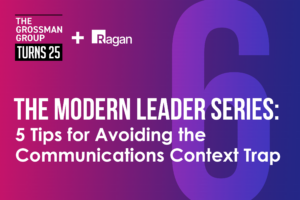How to create consistent executive communications
Former White House communicator shares his thoughts on executive communications.

To all my communicators out there – please stop me if you have heard this one before – “we would like our CEO to do more, but they just don’t value PR and communications.”
This way of thinking – by both the communicator and their executive – creates a roadblock and makes it difficult to take advantage and participate in top-tier media interviews, speak at major conferences, build employee morale at town halls or create a strong corporate narrative.
When looking to dive deeper on how to get executives to buy into the importance of consistent communications, I reached out to Greg Jenkins, who previously served as the deputy assistant to President George W. Bush.
Since serving in the White House, Jenkins has worked for large communications firms, led communications for Alibaba and now serves as the principal of North Bay Strategies, where he focuses on executive coaching and helping big brands like Visa, Nike, Uber and the Los Angeles Dodgers.
Why consistent communication matters from the top
Very few executives fully grasp the true value of effective communications. More experienced CEOs view communications simply as the “cost of doing business,” as Jenkins puts it. On the flip side, many younger founders and CEOs see it as a way to elevate their personal brand – not necessarily just their company’s mission.
As someone who has worked on White House messaging, Jenkins claims that no one values communications more than the president of the United States.
When Jenkins shares that, he often receives pushback from his clients who tell him, “but the President doesn’t have to promote products or speak on behalf of a company.”
While it’s true that there is a difference between the president of the United States and a corporate CEO, the president’s communications strategy does impact how each American describes their country. If the messaging is inconsistent and there is division among country leaders, both national pride and the country’s perception globally is damaged.
In the same vein, inconsistent corporate messaging does have a negative impact on your company’s internal culture and external appeal.
“Consistent communication throughout the entire organization is critical. It is why clients keep coming back and it also plays a big role in recruiting and retaining talent,” Jenkins said.
“Whether you like it or not, every employee is a brand ambassador. While you have a set number of people who are allowed to speak to media, everyone is going to talk about where they work, what they do and what their company is all about,” Jenkins added. “Without consistent communications, what will they say?
Your first step to creating a consistent communication plan
Once your executive understands the value of consistent communications, the initial reaction is usually to do more – more media interviews, more conference keynotes or more town halls. But Jenkins recommends that the first step should be determining what to say and how it can help the company.
“To get started, the most useful thing to pitch [to your executive] is narrative development – not media training,” Jenkins said. “To get them on board, I would tell them; ‘our executive communications are pretty good, but it can be even better. Currently, our leaders are doing their communications in silos. We can let it go, and keep it as it is, or we can come together and speak in one coordinated message to the market.’”
When developing a new corporate narrative, Jenkins starts and ends with the CEO. In between, he interviews the leadership team and other key stakeholders. By taking this approach, he finds that it further commits executives to the narrative and it ‘exposes daylight’ where the leadership team is communicating inconsistently.
Once you have aligned on a consistent, repeatable narrative, then it is a good time to get that media training. And one of the first steps in that training, which gets additional buy-in from executives, is sharing examples of the best communicators – ones like Steve Jobs, Howard Schultz or Bob Iger. But Jenkins also shows less obvious examples like Charles Schwab.
“When I show the less obvious examples, I will be told that this isn’t a narrative or a good story,” Jenkins said. “However, when I breakdown the components of the story, the process that underlies it, why it is a good story and why it matters – it clicks.”
And once “it clicks” – both in understanding the value and how to tell the corporative narrative – your executive would be much more prepared. Now, is the time to do more.
Adam Kiefaber is a global communications director at FIS, a Fortune 500 company focused on creating innovative technology for merchant, banking and investment clients. Previously, he spent nearly 10 years in journalism working for The Cincinnati Enquirer, The Cincinnati Post and CNN. Follow him on LinkedIn.







Top global communications experts like Kiefaber and Jenkins are magnificent at guiding major clients on what to SAY but may have more difficulty in guiding on what to DO. It’s because clients recognize that talking a good game costs less than playing one.
The message that matters most to the public—whether that message comes via one voice or a chorus—is the answer to what the public cares about most: “What are you doing for US?”
If you are helping the public to live longer, earn more or spend less, the public will love you. But if your top message is that you want “fairness” for a company or country, why should 95% of people give a damn? How many of us reading this care whether a CEO sounds passionate about politics, jobs or even national defense?
The key strategic PR question may be “how can we get the public to care about what we want?” The answer may be to tie our cause to what the public already wants, health and money.
My favorite good cause that makes PR successful is health research. Cancer kills but money can kill many kinds of cancer. At Columbia University, Johns Hopkins and Memorial Sloan Kettering Cancer Center, allstar doctors keep looking and finding. If your CEO does a press briefing with Sloan Kettering hematologists Dr. Michael Mauro and Dr. Prioty Islam announcing a research thrust to protect our blood cells against cancer, will the public favor Washington action that may make your company more profitable and your research more successful?
It’s not a selfish question that the public has: “What good news do you have for ME and for US?” That can power your CEO’s success in announcing a new public protection narrative. The more you honestly promise that people care about, the more they will honestly care that Washington and all America should do what you hope for.
Consistently successful executive communications to the public: “What you want is what we want for you.”